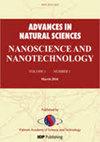Porous pentagraphene nanotube halogen gas sensor: a first principles study
IF 2.1
Q3 MATERIALS SCIENCE, MULTIDISCIPLINARY
Advances in Natural Sciences: Nanoscience and Nanotechnology
Pub Date : 2023-06-01
DOI:10.1088/2043-6262/acd92c
引用次数: 0
Abstract
The recent technological revolution in nanoscience has created a huge potential to build highly sensitive, low-cost and power efficient portable sensors. Here, we have investigated the novel nano-porous penta-graphene nanotube (PGNT) device for detection and separation of halogen gases like fluorine (F2), chlorine (Cl2), bromine (Br2) and iodine (I2). The host carbon atoms are selectively removed to create the nanopores on the tube surface. 1, 2, 3 and 4 host carbon atoms are removed from the surface to create vacancies which were then investigated for detection and separation of halogen gases using functionalisation of pore edges. The I-V measurements were performed to establish the gas detection application of these novel porous structures. Furthermore, interaction energy graphs were obtained which show efficient separation of various halogen molecules by functionalising the pores with F2, Cl2 and H atoms.多孔五烯纳米管卤素气体传感器:第一性原理研究
最近的纳米科学技术革命为制造高灵敏度、低成本和高能效的便携式传感器创造了巨大的潜力。在这里,我们研究了一种新型的纳米多孔五石墨烯纳米管(PGNT)装置,用于检测和分离氟(F2)、氯(Cl2)、溴(Br2)和碘(I2)等卤素气体。宿主碳原子被选择性地去除,在管表面形成纳米孔。从表面去除1,2,3和4个主碳原子以产生空位,然后利用孔隙边缘功能化研究卤素气体的检测和分离。进行了I-V测量,以确定这些新型多孔结构的气体检测应用。此外,得到的相互作用能图表明,通过用F2、Cl2和H原子功能化孔隙,可以有效地分离各种卤素分子。
本文章由计算机程序翻译,如有差异,请以英文原文为准。
求助全文
约1分钟内获得全文
求助全文
来源期刊

Advances in Natural Sciences: Nanoscience and Nanotechnology
NANOSCIENCE & NANOTECHNOLOGYMATERIALS SCIE-MATERIALS SCIENCE, MULTIDISCIPLINARY
自引率
4.80%
发文量
0
 求助内容:
求助内容: 应助结果提醒方式:
应助结果提醒方式:


